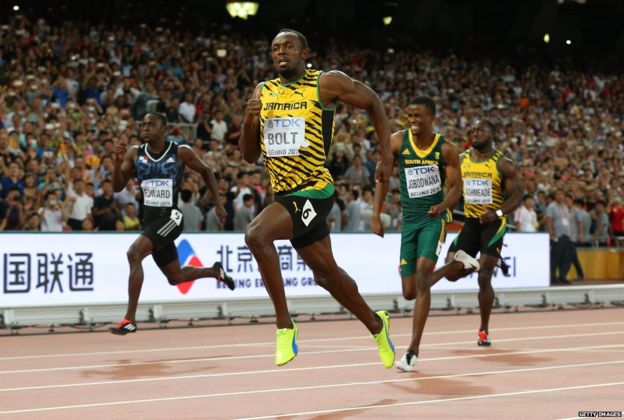
I ran (ha!) across this article by Sam Wuest, thanks to the Steve Morris Facebook page. It’s a really interesting look at how Usain Bolt is the fastest man alive despite not conforming to accepted wisdom on running mechanics.
It turns out Mr Bolt makes clever use of waist rotation when he runs, in contrast to the normal admonitions to reduce rotational movement and increase forward and back movement you’ll get from a lot of running coaches. By turning his waist in coordination with the running motion Mr Bolt is creating a longer lever to the floor, and everybody knows that longer levers create more power than shorter levers over the same distance.
There’s a famous line in the Tai Chi Classics that goes “The waist is like the axle and the ch’i is like the wheel“. At one point in the article, Sam Wuest says
“The rotation of the waist/pelvic region is like the turning of a wheel on an axle. The hip joints are rotating around the imaginary centerline of your body parallel to your spine at about the elevation of the sacrum. It is not a perfect rotation, as the free leg hip will come through higher than the support leg’s hip if the lateral chain is firing correctly. Perhaps it would be better described as a rolling rotation. Which brings us to reason #2 of why this piece of technique is important.”
Sounds familiar, doesn’t it? Reason #2 is interesting too:
Reason #2: Better Muscle Sequencing/Activation
Often, those that rotate better whilst sprinting will look smooth and relaxed. Their strides won’t just look longer, they’ll look more relaxed. Think of Carl Lewis’ famously effortless stride. This is how we are designed to move – the center moves first, then the extremities follow, much like a whip.
The muscles around the pelvis have high muscle-to-tendon ratios (force producers) while the extremities have relatively much more tendon and elastic structures (force amplifiers). In a correctly aligned body, a small movement of the waist can produce large amounts of force elsewhere in the body.
This sounds awfully close to the Tai Chi idea of the dantien as a nexus of muscular and tendon power in the body.
As somebody interested in muscle tendon channels and their effect on movement and silk reeling exercises from Tai Chi I can see the correlation here. Tai Chi uses the same principle of movement coming from the centre (the dantien) and that controlling the movement of the extremities through elastic tissue. We usually think of this sort of movement as having to be learned, rather than occurring naturally, however it appears to be exhibited in high-level athletes, as we see in the article linked to above. Are they just naturally doing it? Have they tapped into the way the body is designed to move? Have they stumbled upon it, or have they had to learn to move this way on purpose?
So he means the waist
LikeLike
Pingback: Jin in Chinese martial arts (and tennis) | The Tai Chi Notebook
@wayne He’s talking about tendons and muscles in the waist/pelvic region, so I think he means whatever attaches to the hip bones, not the hip bones themselves.
LikeLike
But does he mean the waist or the hips
LikeLike
Reblogged this on SMA bloggers.
LikeLike